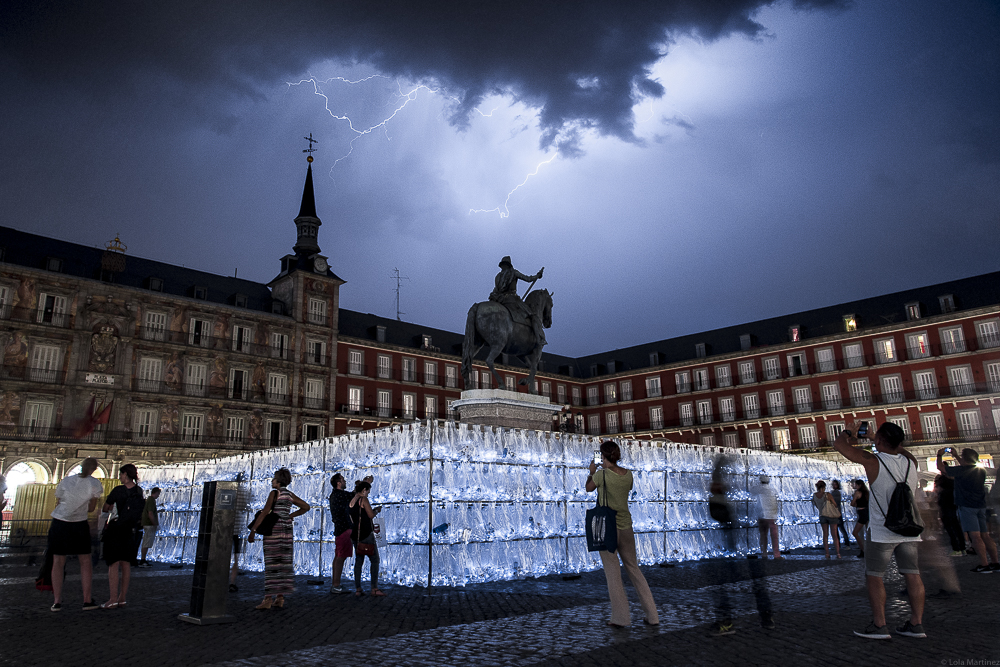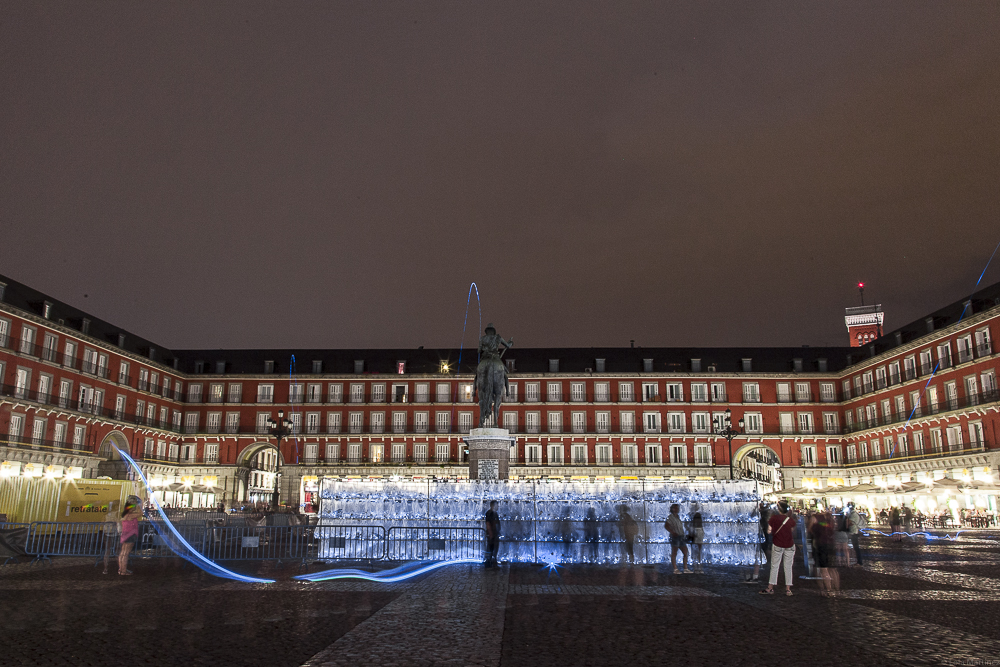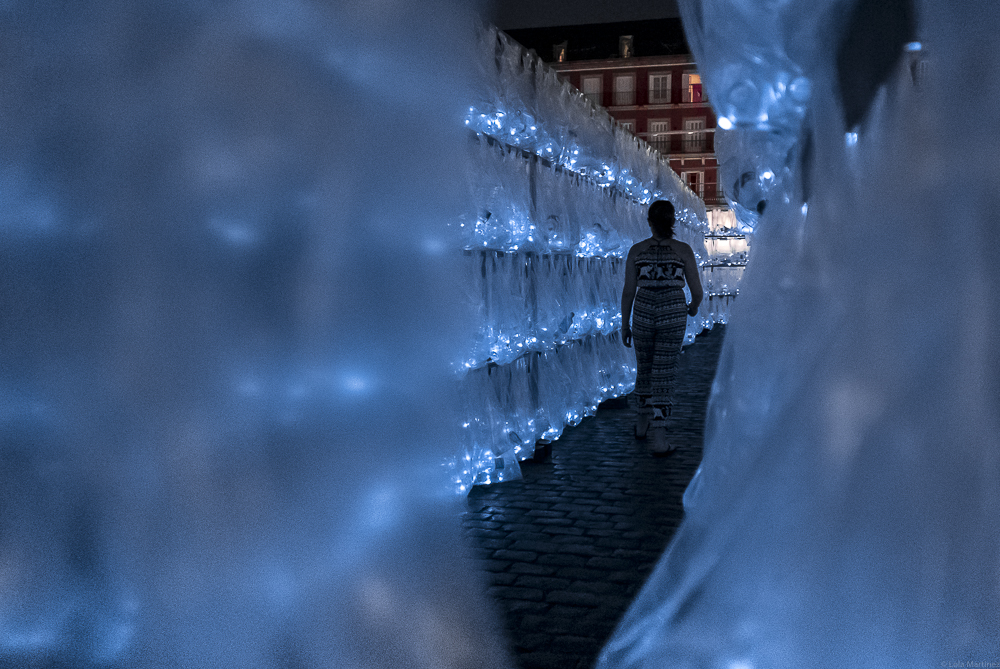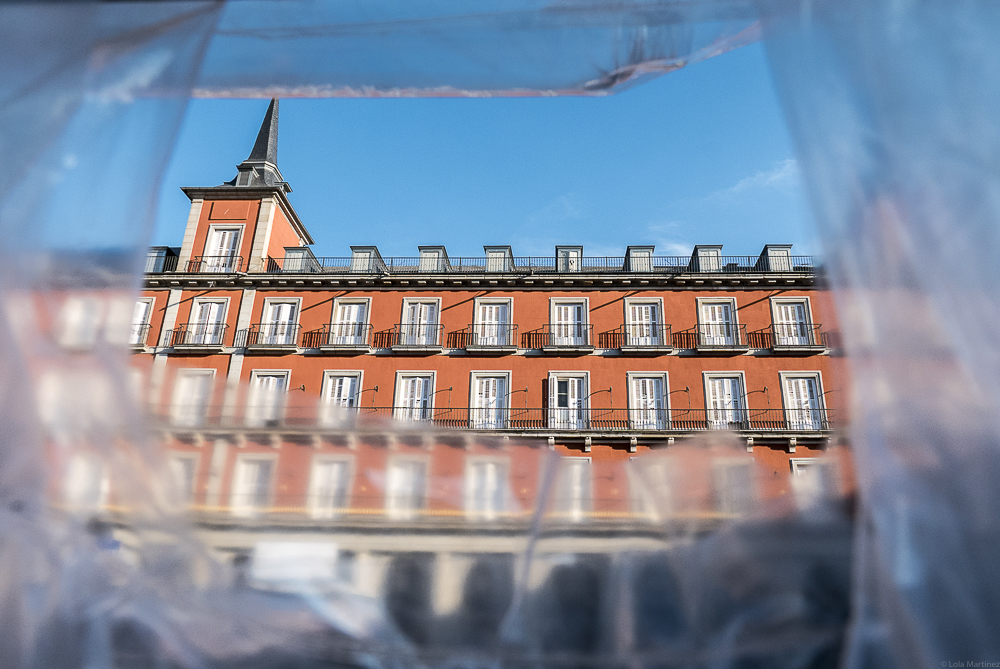Labyrinth of plastic waste / Laberinto de residuos plástico. Madrid 2017
Last June, we were invited by Madrid City Council to participate in the 4th CentennialCelebration of Plaza Mayor within the “Four Seasons” city art program.
In such unique setting, we thought we should create a piece that had something to do with this setting, getting its inhabitants involved. This was somehow complicated as this is a popular tourist attraction which is not frequently visited by us, Madrileños, and where we don’t want to live either.
We decided to build a PlasticWaste Labyrinth, similar to the one we had installed in Poland back in 2014 though this time we were going to make it much bigger, more claustrophobic, and built with the bottles that had been consumed in the square during a month.
The idea was to graphically visualize the amount of plastic we generate in our daily lives which we don’t often recycle accordingly. As a consequence, all this plastic is dumped in nature and ends up floating in the ocean, forming huge plastic islands that are destroying the marine ecosystem and will not ever decompose.
Bearing all this in mind, we thought it was paramount that the piece didn’t look friendly. Quite on the contrary, our intention was to make the public feel certain discomfort when entering it.
In order to achieve this, we build a structure with an intricate path and narrow passages which force visitors to keep turning, thus producing a feeling of disorientation and a certain unease after a few seconds as it was impossible to guess how far the exit was. There were no reference points in its interior and the heat and the smell of plastic enhanced a definitely oppressive experience.
Measurements: The maze corridors were 170 meters long (558 feet long) with 3 meter tall walls (10 feet tall) which took 3 minutes to pace, and an area of 300 m2 (3230 ft2) that sprawled around King Philip III statue.
To raise the walls, we used around 15,000 bottles to which we added lights and put in bags that we hung from the structure, thus achieving walls that were totally compact and bright.
Many people went through the maze which was open day and night for 4 days. The over 40ºC (104º F) temperature helped us in our mission of creating an asphyxiating setting which stood in stark contrast to the magic of the glazes and the bright colorful reflections of the light filtered through the bottles.
To collect the plastic material, we summoned the neighbors whom we invited to donate all the plastic bottles they consumed to us in the days prior to the construction of the piece. In order to collect them, we placed two containers in the square and we also contacted the Asociación de Comerciantes de la Plaza Mayor (Merchants Association of Plaza Mayor) and they offered to keep all the bottles that were consumed at their establishments.
In spite of this, we estimated that all these bottles were not going to be enough so we asked for help at hospitals, universities, official institutions, catering companies, packing companies, and other businesses. They generously kept all the bottles consumed at their premises in a month. This way, we got the 15,000 we needed.
We must say that we found impossible to get plastic bottles from the city’s official recycling services. Unfortunately, here we don’t recycle PET separately and is mixed with all kinds of containers which renders the task of selecting only bottles impossible. In addition, the bodies that regulate and control this sort of material do not make things easy, the exception not being programmed in the plastic collection chain. What we were actually able to see was that the trash collection business brings huge profit to many businesses that manage it and trade it.
We hope things change soon and that municipal services begin to consider the possibility of collecting these materials more selectively since there are many innovative ways to use them. With the defective outdated system currently in place, this seems mission impossible.
We want to thank all the people who helped us in this complicated creative process. The team from the IV Centenario, Cris, Delia, Martina, Curro, Remedios, for thinking about us and making this piece possible. Burna and Montaña, for managing and coordinating all the material. Our friends who helped us prepare the material and the company that built the structure as well as the people who worked from dawn to dusk so everything would look perfect.
Special thanks to the neighbors, the companies and the institutions that helped us get the bottles. This would not have been possible without their disinterested assistance.
Thanks to Lola Martínez for her wonderful photos.
Time of installation: and installation:7 days.
Damages: none.
Exhibition time: 4 days.
——————————————-
EL pasado mes de junio fuimos invitados por el Ayuntamiento de Madrid a participar en la celebración del IV Centenario de la Plaza Mayor dentro de su programa de arte urbano «Cuatro Estaciones».
En este singular entorno, pensamos que debíamos hacer una pieza que tuviera que ver con el contexto, implicando a sus propios habitantes, algo complicado, ya que es una zona eminentemente turística, que los propios madrileños no solemos frecuentar y en la que tampoco queremos vivir.
Decidimos llevar a cabo un Laberinto de Residuos Plásticos, similar al que habíamos instalado en Polonia en el 2014, pero esta vez mucho mas grande, mas claustrofóbico y construido con las botellas consumidas en el entorno de la plaza durante un mes.
La idea, La idea era visualizar de forma gráfica la gran cantidad de plástico que generamos en nuestra vida diaria y que la mayoría de las veces no reciclamos convenientemente, y que acaba abandonado en la naturaleza y flotando en los océanos, llegando a formar enormes islas plásticas que están acabando con el ecosistema marino y que no va a descomponerse nunca.
Pensando en todo esto, nos parecía imprescindible que la pieza no fuera amable, muy al contrario, nuestra intención fue conseguir que el público sinitiera un cierto malestar al internarse en ella.
Para ellos, construimos una estructura de intrincado recorrido y estrechos pasillos, que obligaba al visitante a girar constantemente, lo que a los pocos segundos producía una sensación de desorientación y cierto desasosiego, porque era imposible adivinar cuando se llegaría a la salida. En el interior, no había puntos de referencia y el calor y el olor a plástico, potenciaban una experienca ciertamente opresiva.
En medidas: los pasillos del laberinto tenía una extensión de 170 metros, con paredes de 3m de altura, que consumían unos 3 minutos andando y ocupaban una superficie de 300 metros alrededor de la estatua de Felipe III.
Para levantar las paredes, usamos unas 15.000 botellas a las que añadimos luz y metimos en bolsas que colgamos de la estructura, consiguendo muros totalmente compactos y brillantes.
Pasó mucha gente por el laberinto, que estuvo abierto día y noche durante 4 días. Las temperaturas de mas de 40 grados, nos ayudaron en la misión de crear ese entorno asfixiante que contrastaba con la magia de las veladuras y los reflejos brillantes y coloridos de la luz a través de las botellas.
Para conseguir el material plástico, hicimos un llamamiento a vecinos, a los que invitamos a donarnos todas las botellas de plástico que consumieran en los días previos a la construcción de la pieza. Para recolectarlas, colocamos dos contenedores en la propia plaza, y además nos pusimos en contacto con la Asociación de Comerciantes de la Plaza Mayor que se ofrecieron a guardarnos todas las que se consumieran en sus establecimientos.
Aun así calculábamos que no iban a ser suficientes, por lo que también pedimos ayuda a hospitales, universidades, organismos oficiales empresas de catering, envasadoras y otros establecimientos, que generosamente nos guardaron durante un mes las botellas consumidas en sus instalaciones. De esta manera llegamos a las 15.000 que necesitamos.
No podemos dejar de decir que conseguir botellas de plástico de los servicios oficiales de reciclaje de la ciudad fue imposible. Desgraciadamente aquí no reciclamos el pet separadamente, que se mezcla con envases de todo tipo, lo que hace imposible seleccionar sólo botellas. Además, los organismos que regulan y controlan este material no facilitan mucho las cosas, la excepción no está programada en la cadena de recogida del plástico. Lo que sí pudimos comprobar es que la basura es un negocio que da pingües beneficios a muchas empresas que se dedican a manejarlo y comerciar con él.
Ojalá pronto cambien las cosas y desde los servicios municipales se contemple la posibilidad de hacer una recogida mas selectiva de estos materiales ya que hay muchas e innovadoras maneras de utilizarlos y con este sistema tan arcaico y poco operativo es misión imposible conseguirlo.
Queremos dar las gracias a todas las personas que nos ayudaron en el complicado proceso de creación. Al equipo de IV Centenario, Cris, Delia, Martina, Curro, Remedios por pensar en nosotros y hacer que la pieza se pusiera en pie, a Burna y Montaña por la gestión y la coordinación de todo el material, a los amigos que nos ayudaron a preparar el material y a la empresa que construyó la estructura así como a las personas que estuvieron trabajando de sol a sol para que todo luciera perfecto.
Gracias muy especiales para los vecinos, las empresas e instituciones que nos ayudaron a conseguir las botellas, sin cuya desinteresada ayuda no hubiéramos podido llevarlo a cabo.
Y a Lola Martínez por las maravillosas fotos.
Tiempo de montaje e instalación: 7 días
Daños ocasionados: 0.
Permanencia de la intervención: 4 días.













































